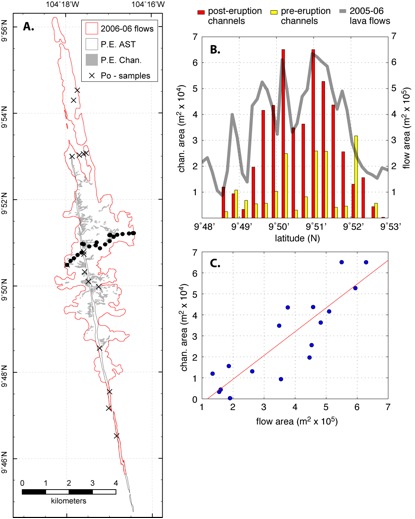Soule
The 2005-06 eruption of the East Pacific Rise: source-vent character, lava flow dynamics, and depositional processes
S.A. Soule¹*, S.W. White², V.L. Ferrini³, A. Fundis⁴, S. Nakata¹, D.J. Fornari¹, M.R. Perfit⁴, K. Rubin⁵, A. Goss⁴
Corresponding author: ssoule@whoi.edu
¹Woods Hole Oceanographic Institution, Geology and Geophysics Dept., Woods Hole, MA, 02543
²University of South Carolina, Columbia, SC, 29208
³Lamont-Doherty Earth Observatory, Columbia University, Palisades, NY
10964
⁴University of Florida, Gainesville, FL, 32601
⁵SOEST-University of Hawaii, Honolulu, HI, 96822
Abstract:
The East Pacific Rise ISS was selected in part for the significant potential to ‘monitor’ a ridge crest through complete volcanic cycle, culminating in an eruptive event. This objective was accomplished when an ~18 km long fissure erupted ~0.016 km3 of basaltic lava in late 2005 to early 2006. This volcanic event is the first repeat eruption observed along any portion of the global mid-ocean ridge (MOR) and, with the abundance of pre-eruption observational data sets and post-eruption surveys, presents an unique opportunity to characterize the caphysical processes controlling the eruption, transport, and deposition of fast-spreading MOR lava flows. Bathymetric, sidescan sonar, and seafloor photographic surveys conducted over the eruption site have allowed us to produce a highly detailed map of the extent of the lava flows produced during the eruption and well-constrained estimates of the volume of material erupted [Soule et al., 2007]. Our recent efforts are focused on refining the eruption map and conducting detailed analyses of the flow morphology and sidescan sonar acoustic textures in order to investigate the mechanisms that controlled the complex flow units produced during several, radiometrically defined eruptive events. Our results suggest that these eruptions produced compound lava flows, with overlapping flow lobes fed from discrete volccaanic vents. We explore controls on lava deposition including pre-existing seafloor topographic gradients and obstacles (e.g., faults), fine-scale segmentation of the eruptive fissure(s), and the thermal/rheologic evolution of the lava. We identify the scale of topographic features that significantly influence lava deposition, thereby providing a mechanism for predicting the length- and time-scale of asymmetries in volcanic accretion at ridge crests. We qualitatively examine the dynamics of the flows by characterizing flow morphologies within and between flow units that exemplify the along- and across-axis variations in volume flux and that define flow pathways. Finally, we examine the geochemical evolution of the lava along flow pathways to constrain the degree of variability in major- and trace-element geochemistry as well as volatile concentrations that can develop through intra-flow differentiation/degassing. These geochemical data also provide rough constraints on the timescale of flow advance and consequently eruption rate, a parameter that can be used to deduce the pressurization of the underlying magmatic system just prior to eruption.
Keywords:
East Pacific Rise, Volcanism, Faulting, Magmatic CO2, Morphology
Contributions to Integration and Synthesis:
Our estimates of the volume and extent of lava emplaced during the 2005-06 eruption relative to past EPR eruptions provides a critical context for interpreting the precursory eruption signals observed in microseismicity and vent fluid chemistry as well as continuing investigations of the disruption and recovery of the ridge crest hydrothermal system(s) and biological communities. Through identification of multiple flow units, it is possible to refine our understanding of the geochemistry of the magmatic system underlying the ridge crest by correlating individual lava sample locations to the temporal and spatial evolution of the eruption. Finally, our refined understanding of lava deposition and crust construction along with our accounting of the variation in lava output along the eruptive fissure, provide a framework in which to interpret the newly collected 3D MCS dataset along the EPR ridge crest.
Figures:
Figure A. The extent of the 2005-06 eruptions (red) was mapped from TowCam imagery and the comparison of pre- and post-eruption DSL120a sidescan sonar backscatter mosaics (left). The eruptive vents (i.e. axial summit trough) are shown in black and distributory lava channels in gray. Samples of 2005-06 lava that have been dated are shown with crosses and along-flow samples with circles. B. The deposition of lava along the axis is highly variable, and is positively correlated with the distribution of lava channels (C), one of the mechanisms controlling the transport and deposition of lava across the ridge crest. Soule_fig1.jpg

